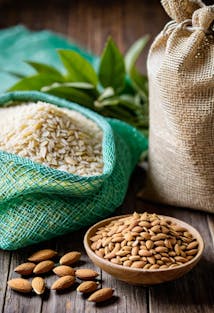DIY Milk Alternatives: Healthier, Tastier, and Eco-Friendly Choices
In recent years, milk alternatives have surged in popularity as more people seek healthier, plant-based options. Making your own milk alternatives at home can be a rewarding, cost-effective, and eco-friendly practice. Here, we explore the benefits of creating homemade milk alternatives, and provide easy recipes for making rice milk and almond milk.
Why Make Your Own Milk Alternatives?
Health Benefits: Homemade milk alternatives are free from preservatives, additives, and excessive sugars often found in store-bought versions. You have full control over the ingredients, ensuring a healthier drink.
Cost-Effective: Making milk alternatives at home is generally more affordable than purchasing pre-packaged ones. Bulk buying ingredients like rice or almonds can save you money in the long run.
Eco-Friendly: Reducing packaging waste is another benefit of DIY milk alternatives. You can significantly cut down on plastic and carton waste by making your own and storing it in reusable containers.
Customization: When you make your own milk alternatives, you can customize the flavor, sweetness, and consistency to suit your personal preferences.
How to Make Rice Milk
Ingredients:
1 cup of cooked white rice (you can also use brown rice for a different flavor and added nutrients)
4 cups of water
Sweetener to taste (optional, such as maple syrup, honey, or dates)
A pinch of salt (optional)
1 tsp of vanilla extract (optional)
Instructions:
Cook the Rice: Begin by cooking your rice according to the package instructions. Let it cool to room temperature.
Blend: In a blender, combine the cooked rice, water, sweetener, salt, and vanilla extract. Blend until smooth.
Strain: Pour the mixture through a fine mesh strainer, cheesecloth, or nut milk bag into a bowl or pitcher. This step removes the rice pulp, leaving you with smooth milk.
Store: Transfer the rice milk to a clean, airtight container and refrigerate. Shake well before each use as separation is natural. It will last up to 4-5 days in the fridge.
How to Make Almond Milk
Ingredients:
1 cup of raw almonds
4 cups of water (plus more for soaking)
Sweetener to taste (optional, such as maple syrup, honey, or dates)
A pinch of salt (optional)
1 tsp of vanilla extract (optional)
Instructions:
Soak the Almonds: Place the almonds in a bowl and cover them with water. Let them soak overnight or for at least 8 hours. This softens the almonds and makes them easier to blend.
Drain and Rinse: After soaking, drain and rinse the almonds thoroughly.
Blend: Combine the soaked almonds and 4 cups of water in a blender. Add the sweetener, salt, and vanilla extract if desired. Blend on high speed until smooth and creamy.
Strain: Pour the mixture through a fine mesh strainer, cheesecloth, or nut milk bag into a bowl or pitcher to remove the almond pulp.
Store: Transfer the almond milk to a clean, airtight container and refrigerate. Shake well before each use as separation is natural. It will last up to 4-5 days in the fridge.
Tips for Making the Best Milk Alternatives
Experiment with Flavors: Don’t hesitate to experiment with additional flavors. Cocoa powder for chocolate milk, cinnamon, or even a touch of coffee can add exciting new dimensions to your homemade milk.
Use Fresh Ingredients: Fresh, high-quality ingredients will yield the best-tasting milk. Ensure nuts are fresh and free from rancidity.
Save the Pulp: Don’t throw away the leftover pulp. It can be used in baking, added to smoothies, or dried and used as flour in various recipes.
Adjust Consistency: If you prefer a creamier milk, use less water. For a lighter milk, add more water.
Conclusion
Making your own milk alternatives like rice milk and almond milk is not only simple but also incredibly rewarding. With just a few ingredients and a bit of time, you can enjoy fresh, delicious, and nutritious milk alternatives tailored to your taste. Plus, by making them at home, you contribute to a healthier lifestyle and a more sustainable environment. So, grab your blender and start experimenting with homemade milk alternatives today!

